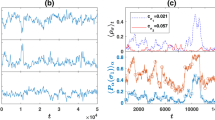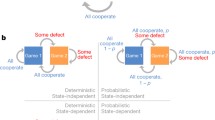Abstract
Recent work on costly signaling games has identified new Nash equilibria in addition to the standard costly signaling equilibrium as a possible explanation for signaling behavior. These so-called hybrid equilibria are Liapunov stable, but not asymptotically stable for the replicator dynamics. Since some eigenvalues of the hybrid equilibria have zero real part, this result is not structurally stable. The purpose of this paper is to show that under one reasonable perturbation of the replicator dynamics—the selection–mutation dynamics—rest points close to the hybrid equilibrium exist and are asymptotically stable. Moreover, for another plausible version of the replicator dynamics—Maynard Smith’s adjusted replicator dynamics—the same is true. This reinforces the significance of hybrid equilibria for signaling.


Similar content being viewed by others
Notes
The order of the publications is somewhat misleading since Wagner was actually the first to recognize the significance of hybrid equilibria for evolutionary games.
The Jacobian matrix of the replicator dynamics is the matrix of partial derivatives of (1) with respect to \(x_1, \ldots , x_4,y_1, \ldots , y_4\). A rest point of the replicator dynamics (2) is hyperbolic if no eigenvalue of the Jacobian matrix of (1) evaluated at the rest point has zero real part.
References
Bergstrom CT, Lachmann M (1997) Signalling among relatives I. Is costly signalling too costly? Philos Trans R Soc Lond Ser B 352:609–617
Bürger R (2000) The mathematical theory of selection, recombination, and mutation. Wiley, New York
Grafen A (1990) Biological signals as handicaps. J Theor Biol 144:517–546
Guckenheimer J, Holmes P (1983) Nonlinear oscillations, dynamical systems, and bifurcations of vector fields. Springer, New York
Hofbauer J (1985) The selection mutation equation. J Math Biol 23:41–53
Hofbauer J, Huttegger SM (2008) Feasibility of communication in binary signaling games. J Theor Biol 254:843–849
Hofbauer J, Huttegger SM (2015) Selection–mutation dynamics of signaling games. Games 6:2–31
Hofbauer J, Sigmund K (1998) Evolutionary games and population dynamics. Cambridge University Press, Cambridge
Huttegger SM, Zollman KJS (2010) Dynamic stability and basins of attraction in the Sir Philip Sidney game. Proc R Soc Lond B 277:1915–1922
Maynard Smith J (1982) Evolution and the theory of games. Cambridge University Press, Cambridge
Maynard Smith J (1991) Honest signalling: the Philip Sidney game. Anim Behav 42:1034–1035
Nowak MA (2000) Evolutionary biology of language. Philos Trans R Soc B 355:1615–1622
Nowak MA, Komarova NL, Niyogi P (2002) Computational and evolutionary aspects of language. Nature 417:611–617
Searcy WA, Nowicky S (2005) The evolution of animal communication. Princeton University Press, Princeton
Spence M (1973) Job market signaling. Quart J Econ 87:355–374
Taylor PD, Jonker L (1978) Evolutionarily stable strategies and game dynamics. Math Biosci 40:145–156
Wagner EO (2013) The dynamics of costly signaling. Games 4:161–183
Weibull J (1995) Evolutionary game theory. MIT Press, Cambridge
Zahavi A (1975) Mate selection—the selection of a handicap. J Theor Biol 53:205–214
Zollman KJS, Bergstrom CT, Huttegger SM (2013) Between cheap and costly signals: the evolution of partially honest communication. Proc R Soc Lond B 280:20121878
Acknowledgments
We would like to thank Josef Hofbauer and Carl Bergstrom for helpful comments. This material is based upon work supported by the National Science Foundation under Grant No. EF 1038456. Any opinions, findings, and conclusions or recommendations expressed in this material are those of the authors and do not necessarily reflect the views of the National Science Foundation.
Author information
Authors and Affiliations
Corresponding author
Rights and permissions
About this article
Cite this article
Huttegger, S.M., Zollman, K.J.S. The Robustness of Hybrid Equilibria in Costly Signaling Games. Dyn Games Appl 6, 347–358 (2016). https://doi.org/10.1007/s13235-015-0159-x
Published:
Issue Date:
DOI: https://doi.org/10.1007/s13235-015-0159-x




